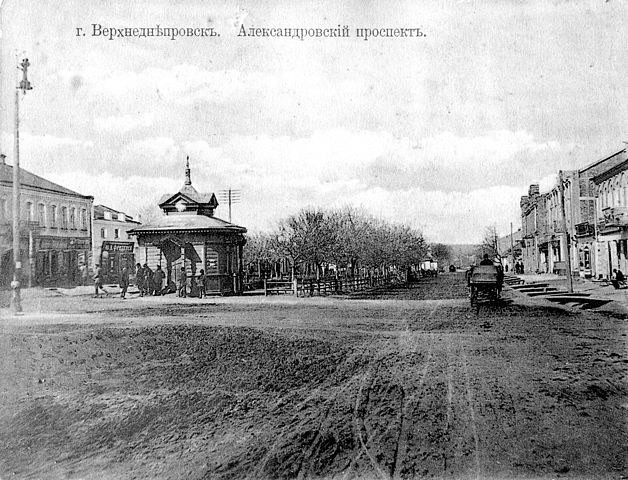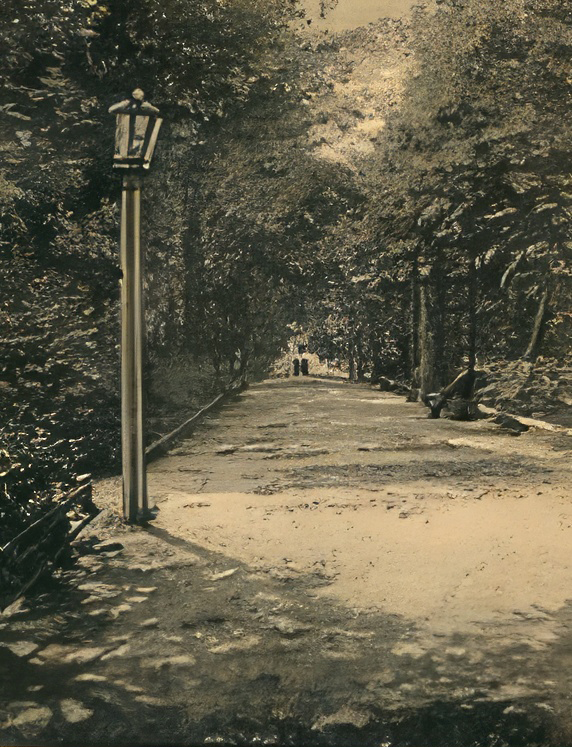Verkhnedneprovsk, Ukraine

Verkhnedneprovsk Town Garden, early 20th century

Verkhnedneprovsk Town Garden, early 20th century
The land where Verkhnedneprovsk is located has been inhabited since ancient times, based on burial mounds from the 2nd or 3rd century BCE. A very small settlement was located here at least as far back as the 17th century and a later settlement named Grigoryevna was founded in 1779. Three years later, the settlement was renamed Novogrigoryevka and intended for the settlement of retired soldiers. On June 5, 1806 it received the status of a district town and was renamed Verkhnedneprovsk (see etymology of the name on the Home/Location page).
The image above is an entrance to the Verkhnedneprovsk Town Garden, early 20th century. Below is another image of the Town Garden from the same era. The park's paths were lit by kerosene lanterns.

Population development:
1818: population total 521 (187 military settlers, 101 Cossacks, 67 state peasants). No mention of Jews.Preminary figures for Jewish population and % of total population (where available):
1847: 265
1864: 538
1897: 2,058 (30.7%)
1910: 4,113 (33.8%)
1920: 1,551
1923: 1,192
1926: 914 (15.5%)
1939: 282 (or 119 according to another source) - a minute % of the population total, most of whom were subsequently killed (see Holocaust page).
The most common occupation of the Jews of Verkhnedneprovsk in the 19th century was clothing manufacturing. At the turn of the 20th century, most of Verkhnedneprovsk's jews were tailors or merchants who owned many of the town's shops.
The rabbis in Verkhnedneprovsk were: from 1861 - Moses Rubin (1832-?), in the 1890s - Simcha Ginzburg, from 1905 - Leib Heifetz (1844-?), in the 1910s - Leiba Girshovich Dotlibov.
By 1861, there were three synagogues in Verkhnedneprovsk and a Hevra Kadisha, a Jewish burial society.
In 1905, there was a pogrom in Verkhnedneprovsk during which Jewish property was looted.
In 1907, 15 prayer institutions were officially registered in the district and the city.
In 1909, there was a Talmud Torah and three Jewish schools: two private and one public.
In 1919-1920 there were pogroms in the town. A number of Jews were murdered, including the head of the Jewish community.
"... the steamship Vilna approached the [Verkhnedneprovsk] port...At midnight six men boarded the ship and demanded a ransom of 12,000 rubles from the passengers. The passengers collected this sum and gave it to those demanding it. At two a.m about twenty armed men boarded the ship, took all the men off the ship, lowered them to the shore, stripped them of their clothes, and left them only in underpants...They beat the people they were robbing, and when they found gold teeth in their mouths they yanked them out. When they had finished their work with the men, they put the eighteen young Jewish women who were on the ship on shore and raped them all...They carried out this outrage before all our eyes. The abuse and rape continued until noon."